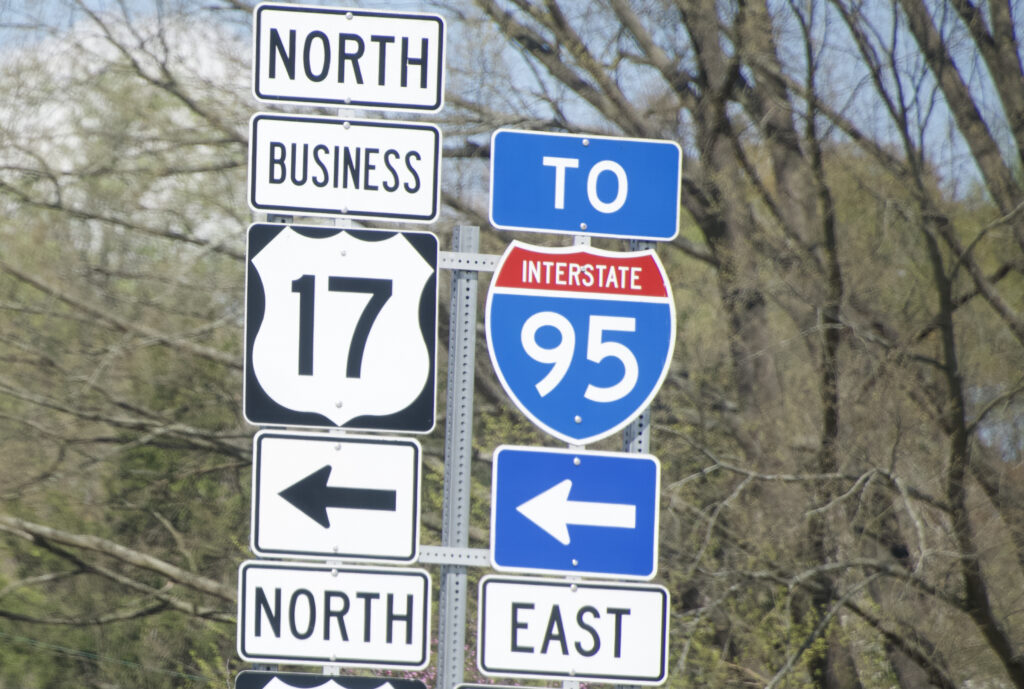Travel hurdles in Fredericksburg: Commuters struggle on Interstate 95
4 min read
Signs direct drivers to Interstate 95 east. | Abbey Magnet, The Weekly Ringer
by MANDY SOUZA
Staff Writer
If you have ever traveled on Interstate-95 in Virginia, then you have no doubt experienced traffic delays of some kind. It’s inevitable, and while some lucky Virginians don’t have to deal with the congestion on a daily basis, for most of us, there is no way around it unless you want to take tedious backroads or Route 1.
I commute every single day all the way to Chesterfield, and my only viable way of getting to work is to take I-95. I could take a significantly longer route that takes me out of my way, or at some point I could jump on a toll road, but this would cost over $70.00 a week if used daily in addition to what I already spend on gas everyday.
When you get on I-95, you can’t predict anything; everything is left to chance. You would have better chances of rolling the dice at your favorite casino and winning the jackpot.
After sitting in traffic, stressing the whole way and finally making it to campus, I still have to find parking and run to class. This is so stressful and just ruins the whole experience for many commuter students.
“I think people forget to factor in the energy it takes to commute back and forth. Gas prices are a factor – in more difficult economic times I’ve had students tell me they can’t afford the gas to get to school. And it certainly impacts involvement on campus – if your classes end at 4 [p.m.] but there is something you want to do at 8 p.m., do you hang out? Go home and come back?” said Assistant Dean of Students CJ Porter.
According to the Fredericksburg Department of Economic Development, I-95 carries over 150,000 vehicles per day in Fredericksburg alone. This stretch of I-95 hosts some of the heaviest volume of traffic in the country, and a national study from 2017 concluded that Fredericksburg and its surrounding counties have the worst traffic hotspot in the country.
Even after some improvements, the change that the Interstate needs has not been properly met. Widening the highway and implementing paid routes with EZ-Pass has not improved the traffic situation, and therefore there should be more routes that provide efficient transportation from north to south.
In July 2019, the Express Lane Project began, which aimed to extend the I-95 Express Lanes by approximately 10 miles. The route extended from south of Route 610 on Garrisonville Road in Stafford County to the vicinity of Route 17 on I-95 Exit 133. The project took four years to complete and cost Virginia taxpayers $670 million to construct. And yet, it still hasn’t solved the problem.
While Express Lanes offer an easier route for some, the cost of access is a barrier for others.
“I was not a fan of switching over the HOV lanes to for-profit use. Where we used to be able to use the lanes during off times for free, now it costs money. And the variable pricing (the worse the traffic, the higher the fee) feels like I’m being taken advantage of,” said Porter. “Sometimes I will use the HOV lanes and pay the price when I absolutely have to otherwise, it’s the traffic jam for me.”
For students who commute to campus on the Interstate, they often run into trouble getting to school because of the traffic. Despite the attempted improvements, they haven’t noticed many changes in the traffic flow.
“Over the past few years, I haven’t really seen any improvements at all in terms of congestion. As a matter of fact, I believe that it has gotten worse, especially after Raising Cane’s opened in the fall semester,” said Charlie Li, a senior communication and digital studies major who commutes to campus. “If I-95 becomes congested, it spills into Route 3 which eventually ends up causing a lot of traffic on Route 1.”
Li isn’t the only commuter who has noticed the density of traffic on the interstate.
“In my opinion, I-95 traffic has gotten worse recently,” said Jenny Wolfe, a senior political science major who commutes to campus. “Both the Northbound and Southbound lanes have pockets of construction that slow things down. The Southbound 126 Exit is a nightmare every single day, as its inefficient let-out backs up traffic up to 5 miles back.”
Furthermore, relying on the Virginia Railway Express and Amtrak works for some, but this is not a practical solution for everyone, especially if they don’t live near a station. Even with a larger, more developed mass transit system, it would take years—if not decades—to complete. Plus, how many of us would actually want to take it?










